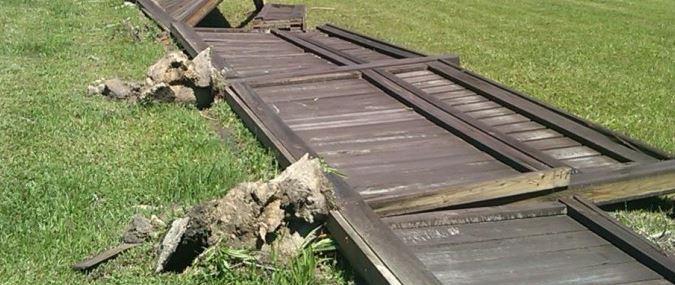Winter Fence Damage: Signs and Solutions
Even though March 20th marks the official first day of spring, temperatures are rising throughout the nation. For many of us, this is a major relief. No more endlessly gray skies or jumpstarting cars before the morning commute. Less plowing your driveway, fewer carwashes, not as many jugs of washer fluid cluttering up the garage. However, the departure of colder months doesn’t necessarily mean we’re done dealing with winter. With the snow fully melted and the ground completely clear, now’s the time to give your fence a proper post-winter inspection. In today’s blog post, American Fence Company covers telltale signs of winter fence damage. Look for these aftereffects.
Changes in post foundation
Although water springs to mind as the substance most vulnerable to temperature change, terrain is also directly—and noticeably—impacted. The ground becomes increasingly solid as below-freezing conditions set in, to the point where you can drive vehicles and haul heavy equipment across the surface without causing yard damage. Dr. Brad Joern, writing on Climate.com, notes that “[a]s the ice melts, the flow of water carves new pathways into the soil. In certain clay soils, the wet-dry cycle also creates a similar expansion and contraction effect to reform the soil structure.” On the flip side, terrain also changes when everything thaws; this can result in the soil around your posts shifting. From that comes changes in foundation and compromises to your fence’s integrity. Significant changes that go uncorrected can result in the entire fence becoming distorted, weakened, and even broken.
Once the ground’s clear of snow, examine the soil surrounding your foundation and verify the posts are not becoming misaligned.
Rust on your metal fences
Here at American Fence Company, we take extra measures to provide rust-resistant fences. Our chain link, for example, comes in galvanized form (which includes a protective zinc coating) or with a fine outer layer of black vinyl. Other fence contractors, however, don’t necessarily take such precautions. If your fence doesn’t have these protective measures, make post-winter inspections a top priority. Winter means snow and ice, which in spring melts and runs across your fence surface. This, combined with other-seasonal exposure to rain, sprinkler water, etc. can lead to corrosion. As noted in this article on Hunker.com, “When a region receives a great deal of snow or ice on the roads, the result is that the local department of roads or highways will put salt or other de-icing substances down on the roads. Salt and other substances put down to deal with icy roads greatly increase the rate at which rust forms on buildings, vehicles and other structures.”
Rust is not only visually unappealing but a potential health hazard. The last thing you want is your kid—or the neighbor’s kid—needing a tetanus shot because they cut themselves climbing your rusty fence.
Wood fence distortions after winter
Of all the fence types on the market, wood remains the one most negatively impacted by winter. What people often forget is that lumber, while cut from a tree that’s no longer alive, retains its water-absorptive properties. (It never gives up its “thirst,” so to speak.) So any fluids it comes in contact with soak into the surface. When winter hits and the thermometer’s mercury meter dips below freezing, the contained fluids transform into ice. This pushes apart the wood’s interior, causing those nasty cuts, bulges, and knots often seen on wood fences after winter. And in spring, as rain falls, the process starts all over again.
For this reason, painting and staining a wood fence is integral. These protective coatings essentially form a surface-level seal, preventing liquids from absorbing into your fence posts, rails, etc. One last tip: although the weather’s getting nicer now, never assume that winter’s really over. As a longtime Midwest resident, you know very well that, even in March and April, a beautiful 50-degree spring day can easily be followed by a blizzard and subzero temperatures. If you’ve made repairs to your wood fence before winter gets its last breath, you could end up replacing everything all over again.
American Fence Company has operated in the Midwest since 1967. In those 50+ years, we’ve accumulated unsurpassed mastery in repairing winter fence damage. If your chain link fence is developing rust, or if knots and bulges are forming in your wood fence panels, etc., we can make the necessary repairs and replacements.


